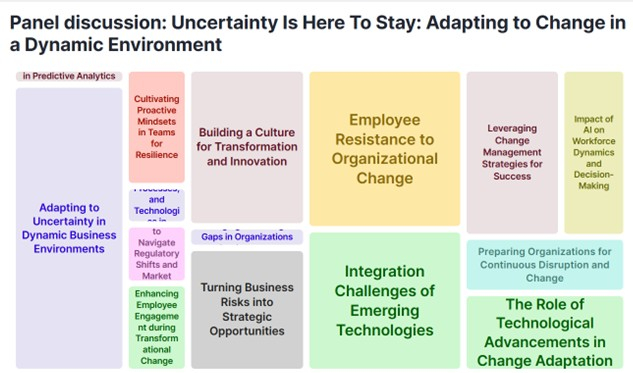Embracing uncertainty: 10 strategies for thriving in a changing business environment
Ramnath Natarajan and Tyson Browning explore adapting to change in a dynamic environment
Add bookmark
In a compelling panel discussion at All Access: Change Management for Business Transformation 2025, Ramnath Natarajan, director of intelligent automation and enterprise integration at Johnson Controls and Tyson Browning, professor of operations management at Neeley School of Business explored adapting to change in a dynamic environment.
The panelists identified employee resistance and technology integration as the foremost challenges organizations face when adapting to change, compounded by supply chain disruptions and geopolitical uncertainties. They drew insightful contrasts between agile startups that attract risk-takers and larger, more change-resistant organizations with established processes and risk-averse cultures.
To foster employee engagement amidst continuous change, the panelists advocated for creating a culture that embraces transformation. They recommended involving employees in change processes, providing flexible tools and addressing evolving workforce expectations.
Join the PEX Network community

Don't miss any news, updates or insider tips from PEX Network by getting them delivered to your inbox. Sign up to our newsletter and join our community of experts.
Learn MoreLeaders were urged to cultivate a proactive, risk-taking environment that encourages curiosity and experimentation. The speakers emphasized the value of scenario planning and questioning assumptions, including environmental considerations in strategic decision-making.
The panel underscored the importance of effective communication and a holistic approach to change management that integrates people, processes and technology. They provided practical advice for navigating uncertainty, emphasizing the need for organizational agility in responding to disruptions ranging from supply chain issues to geopolitical shifts.
Ultimately, the speakers encouraged viewing change not as a threat but as an opportunity for growth and innovation, positioning continuous learning and adaptation as key to thriving in today’s dynamic business environment.
Here are 10 strategies for thriving in a changing environment!

Click here to open our interactive thought cloud!
1. Embracing change as the new normal
Organizations need to develop strategies and mindsets that treat change as a constant, rather than an exception, to thrive in today’s dynamic business landscape. Organizations need to be able to adapt to change quickly, shaping business strategies and operations for competitive advantage.
2. Proactive approaches to uncertainty
Successful adaptation requires anticipating potential changes and preparing for various scenarios, rather than reacting to disruptions as they occur. Part of the problem is that organizations are often caught flat-footed because they weren’t anticipating these opportunities and can’t take advantage of them.
3. Turning uncertainty into advantage
Organizations that can manage uncertainty more effectively than their competitors can transform challenges into strategic advantages. If variability and uncertainty is less costly to you than to your competitors, then it can be a strategic advantage.
4. Encouraging scenario planning
Leaders should foster a culture of scenario planning and critical thinking to prepare teams for various potential future outcomes. Getting teams to question their assumptions and think about some future scenarios is healthy.
5. Fostering a culture of curiosity
Leaders should encourage curiosity and experimentation within their teams to drive innovation and adaptability in the face of change. If you foster a culture of curiosity in your teams, they will catch up. We can’t create a plan for everything, but understanding scenarios and giving space for experimentation is critical.
Watch the full session now!
6. Celebrating learning from failure
Organizations should create an environment where failures are seen as learning opportunities, encouraging risk-taking and innovation. Sometimes it’s wrong to only include the wins. We should celebrate failures too, as they are part of the learning process.
7. Addressing employee concerns
Effective change management requires understanding and addressing employee concerns to reduce resistance and foster engagement. It’s important to create a forum where people can voice their concerns, share ideas and get context. It makes a big difference.
8. Inclusive change processes
Involving employees in the change process and making them feel part of the team, rather than subjects of change, can significantly reduce resistance. Companies often just treat culture as a check-the-box exercise. It’s important that employees feel they are part of the team, not just subjects of the change.
9. Proactive risk management
Organizations should adopt a proactive approach to risk management, identifying potential opportunities within challenges. You’ve got to be proactive.
10. Balancing technology and human skills
While integrating new technologies, organizations must ensure that employees maintain critical thinking skills and don’t become overly dependent on automated systems. We want employees to learn, not just depend on technology as a crutch. It’s a danger for our workforce if workers are not experienced enough to make good decisions themselves and rely on what the ‘black box’ technology tells them.
All Access: Future of BPM 2026

You asked, and we listened. Business process management (BPM) remains the cornerstone technology for driving organizational transformation, according to the survey results featured in the latest PEX Report. As we look toward 2026 and beyond, generative AI, agentic AI, and intelligent process orchestration are redefining how processes are designed, executed, and optimized. BPM is your key to adapting swiftly and effectively in this new era.
PEX Network is bringing together industry leaders, technology innovators, and thought leaders to answer your biggest questions and explore the advancements reshaping business today. And you're invited. Register for free to save your spot now!
Register Now


















